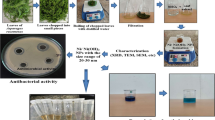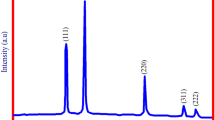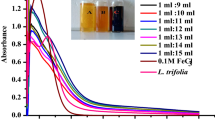Abstract
Utilizing Aloe vera gel (AVG) extracts as reducing agents, the hydrothermal synthesis of dual-functional iron oxide nanoparticles (Fe2O3 NPs) offers a straightforward and environmentally friendly approach. AVG extract, rich in polyphenol complexes and antimicrobial compounds, serves both as a reducing agent for ferric chloride in aqueous solutions and as a stabilizing agent for the resulting nanoparticles. This method showcases the potential of natural plant biomolecules in nanoparticle synthesis. UV–Vis spectroscopy, X-ray diffraction (XRD), scanning electron microscopy (SEM), differential scanning calorimetry (DSC), vibrating sample magnetometry (VSM) and energy dispersive X-ray spectroscopy (EDX) were used to characterise the Aloe vera gel –Fe2O3 nanoparticles (AVGF NPs). The pattern on the XRD indicated the production of crystalline material, which matched JCPDS card no. 89–0596 precisely. Nondestructive XRD analysis indicated a rhombohedral phase crystalline structure, whereas scanning electron microscopy revealed a spherical form. Surface morphology images exhibited that the NPs have sphere-shaped with a size in the range 10–40 nm and magnetic measurements is a high saturation magnetization value of 73.9 emu were synthesised. Bragg’s reflection speaks indicated that the rhombohedral phase structure of AVGF NPs. The thermal stability and functional groups analysis results indicated that the presence of the AVG on the Fe2O3 surface. Moreover, the AVGF NPs had different coloring reflectance on the solution to confirm by absorption spectra. These findings suggest that the formation of AVGF NPs in producing great stable, fluorescence lifetime (26.21 ns), more lasting magnetic characteristics ideal for a variety scenarios primarily effective antimicrobial properties against Gram-positive bacteria and potential conversion of hazardous Cr6+ to less harmful Cr3+ and promising AVGF catalyst efficacy for methylene blue discoloration.

















Similar content being viewed by others
Data Availability Statement
The data are available from the corresponding author upon reasonable request.
References
Al-Tohamy, R., Ali, S. S., Li, F., Okasha, K. M., Mahmoud, Y.A.-G., Elsamahy, T., et al. (2022). A critical review on the treatment of dye-containing wastewater: Ecotoxicological and health concerns of textile dyes and possible remediation approaches for environmental safety. Ecotoxicology and Environmental Safety, 231, 113160. https://doi.org/10.1016/j.ecoenv.2021.113160
Alwin David, S., Doss, A., Powel Praveen Pole, R., Pushpabai Kumari Pushpa Rani, T., Padma Latha Reshmi, R., & Rajalakshmi, R. (2022). Synthesis and characterization of Cobalt Oxide nanoparticles using Momordica charantia and its photocatalytic activity. International Journal of Nano Dimension, 13, 335–343. https://doi.org/10.22034/IJND.2022.1956438.2137
Baruah, A., Bordoloi, M., & Deka Baruah, H. P. (2016). Aloe vera: A multipurpose industrial crop. Industrial Crops and Products, 94, 951–963. https://doi.org/10.1016/j.indcrop.2016.08.034
Basaleh, A. S., & Zaki, Z. I. (2022). MnCo3O4–ZnO heterojunctions for extremely effective photoreduction of Cr6+ ions in aqueous solution utilizing visible illumination. Optical Materials, 129, 112543. https://doi.org/10.1016/j.optmat.2022.112543
Bawankar, R., Deepti, V. C., Singh, P., Subashkumar, R., Vivekanandhan, G., & Babu, S. (2013). Evaluation of Bioactive Potential of an Aloe vera Sterol Extract. Phytotherapy Research, 27(6), 864–868. https://doi.org/10.1002/ptr.4827
Cai, M., Liu, Y., Dong, K., Chen, X., & Li, S. (2023). Floatable S-scheme Bi2WO6/C3N4/carbon fiber cloth composite photocatalyst for efficient water decontamination. Chinese Journal of Catalysis, 52, 239–251. https://doi.org/10.1016/S1872-2067(23)64496-1
Clemente, I., Ristori, S., Pierucci, F., Muniz-Miranda, M., Salvatici, M. C., Giordano, C., et al. (2017). Gold Nanoparticles from Vegetable Extracts Using Different Plants from the Market: A Study on Stability. Shape and Toxicity. Chemistryselect, 2(30), 9777–9782. https://doi.org/10.1002/slct.201701681
Danish, P., Ali, Q., Hafeez, M., & Malik, A. (2020). Antifungal and antibacterial activity of aloe vera plant extract. Biological and Clinical Sciences Research Journal, 2020(1). https://doi.org/10.54112/bcsrj.v2020i1.4
Dhal, B., Thatoi, H. N., Das, N. N., & Pandey, B. D. (2013). Chemical and microbial remediation of hexavalent chromium from contaminated soil and mining/metallurgical solid waste: A review. Journal of Hazardous Materials, 250–251, 272–291. https://doi.org/10.1016/j.jhazmat.2013.01.048
Flores-López, M. L., Romaní, A., Cerqueira, M. A., Rodríguez-García, R., Jasso de Rodríguez, D., & Vicente, A. A. (2016). Compositional features and bioactive properties of whole fraction from Aloe vera processing. Industrial Crops and Products, 91, 179–185. https://doi.org/10.1016/j.indcrop.2016.07.011
He, X., & Li, P. (2020). Surface Water Pollution in the Middle Chinese Loess Plateau with Special Focus on Hexavalent Chromium (Cr6+): Occurrence, Sources and Health Risks. Exposure and Health, 12(3), 385–401. https://doi.org/10.1007/s12403-020-00344-x
Islam, M. T., Islam, T., Islam, T., & Repon, M. R. (2022). Synthetic Dyes for Textile Colouration: Process, Factors and Environmental Impact. Textile & Leather Review, 5, 327–373. https://doi.org/10.31881/TLR.2022.27
Islam, M. M., Mohana, A. A., Rahman, M. A., Rahman, M., Naidu, R., & Rahman, M. M. (2023). A Comprehensive Review of the Current Progress of Chromium Removal Methods from Aqueous Solution. Toxics, 11(3). https://doi.org/10.3390/toxics11030252
Ismail, M., Akhtar, K., Khan, M. I., Kamal, T., Khan, M. A., Asiri, M., A., et al. (2019). Pollution, Toxicity and Carcinogenicity of Organic Dyes and their Catalytic Bio-Remediation. Current Pharmaceutical Design, 25(34), 3645–3663. https://doi.org/10.2174/1381612825666191021142026
Jesumani, V., Du, H., Pei, P., Aslam, M., & Huang, N. (2020). Comparative study on skin protection activity of polyphenol-rich extract and polysaccharide-rich extract from Sargassum vachellianum. PLoS ONE, 15(1). https://doi.org/10.1371/journal.pone.0227308
Kamaraj, C., Gandhi, P. R., Ragavendran, C., Sugumar, V., Kumar, R. C. S., Ranjith, R., et al. (2022). Sustainable development through the bio-fabrication of ecofriendly ZnO nanoparticles and its approaches to toxicology and environmental protection. Biomass Conversion and Biorefinery. https://doi.org/10.1007/s13399-022-03445-6
Kavitha, S., Ranjith, R., Jayamani, N., Vignesh, S., Palanivel, B., Djellabi, R., et al. (2022). Fabrication of visible-light-responsive TiO2/α-Fe2O3-heterostructured composite for rapid photo-oxidation of organic pollutants in water. Journal of Materials Science: Materials in Electronics, 33(11), 8906–8919. https://doi.org/10.1007/s10854-021-06971-7
Khan, M. Z., Gul, I. H., Baig, M. M., & Khan, A. N. (2020). Comprehensive study on structural, electrical, magnetic and photocatalytic degradation properties of Al3+ ions substituted nickel ferrites nanoparticles. Journal of Alloys and Compounds, 848. https://doi.org/10.1016/j.jallcom.2020.155795
Kumar, V., & Dwivedi, S. K. (2021). A review on accessible techniques for removal of hexavalent Chromium and divalent Nickel from industrial wastewater: Recent research and future outlook. Journal of Cleaner Production, 295, 126229. https://doi.org/10.1016/j.jclepro.2021.126229
Kunnamareddy, M., Natchimuthu, K., Tangavelu, K., Palanisamy, S., Diravidamani, B., Arumugam, P., & Rajendran, R. (2023). Enhanced visible light photocatalytic degradation of methylene blue dye using efficient Mg/S co-doped TiO2 nanoparticles. Biomass Conversion and Biorefinery. https://doi.org/10.1007/s13399-023-04278-7
Li, S., Wang, C., Liu, Y., Xue, B., Jiang, W., Liu, Y., et al. (2021). Photocatalytic degradation of antibiotics using a novel Ag/Ag2S/Bi2MoO6 plasmonic p-n heterojunction photocatalyst: Mineralization activity, degradation pathways and boosted charge separation mechanism. Chemical Engineering Journal, 415, 128991. https://doi.org/10.1016/j.cej.2021.128991
Li, S., Cai, M., Liu, Y., Wang, C., Yan, R., & Chen, X. (2023a). Constructing Cd0.5Zn0.5S/Bi2WO6 S-scheme heterojunction for boosted photocatalytic antibiotic oxidation and Cr(VI) reduction. Advanced Powder Materials, 2(1), 100073. https://doi.org/10.1016/j.apmate.2022.100073
Li, S., Cai, M., Wang, C., & Liu, Y. (2023b). Ta3N5/CdS Core-Shell S-scheme Heterojunction Nanofibers for Efficient Photocatalytic Removal of Antibiotic Tetracycline and Cr(VI): Performance and Mechanism Insights. Advanced Fiber Materials, 5(3), 994–1007. https://doi.org/10.1007/s42765-022-00253-5
Li, S., Dong, K., Cai, M., Li, X., & Chen, X. (2023c). A plasmonic S-scheme Au/MIL-101(Fe)/BiOBr photocatalyst for efficient synchronous decontamination of Cr(VI) and norfloxacin antibiotic. eScience, 100208. https://doi.org/10.1016/j.esci.2023.100208
Li, S., Wang, C., Dong, K., Zhang, P., Chen, X., & Li, X. (2023d). MIL-101(Fe)/BiOBr S-scheme photocatalyst for promoting photocatalytic abatement of Cr(VI) and enrofloxacin antibiotic: Performance and mechanism. Chinese Journal of Catalysis, 51, 101–112. https://doi.org/10.1016/S1872-2067(23)64479-1
Li, S., Wang, C., Liu, Y., Liu, Y., Cai, M., Zhao, W., & Duan, X. (2023e). S-scheme MIL-101(Fe) octahedrons modified Bi2WO6 microspheres for photocatalytic decontamination of Cr(VI) and tetracycline hydrochloride: Synergistic insights, reaction pathways, and toxicity analysis. Chemical Engineering Journal, 455, 140943. https://doi.org/10.1016/j.cej.2022.140943
Li, S., Yan, R., Cai, M., Jiang, W., Zhang, M., & Li, X. (2023f). Enhanced antibiotic degradation performance of Cd0.5Zn0.5S/Bi2MoO6 S-scheme photocatalyst by carbon dot modification. Journal of Materials Science & Technology, 164, 59–67. https://doi.org/10.1016/j.jmst.2023.05.009
Ma, W., Rajput, G., Pan, M., Lin, F., Zhong, L., & Chen, G. (2019). Pyrolysis of typical MSW components by Py-GC/MS and TG-FTIR. Fuel, 251, 693–708. https://doi.org/10.1016/j.fuel.2019.04.069
Maan, A. A., Nazir, A., Khan, M. K. I., Ahmad, T., Zia, R., Murid, M., & Abrar, M. (2018). The therapeutic properties and applications of Aloe vera : A review. Journal of Herbal Medicine, 12, 1–10. https://doi.org/10.1016/j.hermed.2018.01.002
Loutfy H. Madkour. (2023). Eco-friendly Green Biosynthesized Metallic Nanoparticles and Biotechnological Applications in Pharmaceuticals Sciences. Journal of Materials Science and Engineering B, 13(1). https://doi.org/10.17265/2161-6221/2023.1-3.001
Mahdavi, M., Namvar, F., Ahmad, M. B., & Mohamad, R. (2013). Green biosynthesis and characterization of magnetic iron oxide (Fe3O4) nanoparticles using seaweed (Sargassum muticum) aqueous extract. Molecules, 18(5), 5954–5964. https://doi.org/10.3390/molecules18055954
Makarov, V. V., Makarova, S. S., Love, A. J., Sinitsyna, O. V., Dudnik, A. O., Yaminsky, I. V., et al. (2014). Biosynthesis of Stable Iron Oxide Nanoparticles in Aqueous Extracts of Hordeum vulgare and Rumex acetosa Plants. Langmuir, 30(20), 5982–5988. https://doi.org/10.1021/la5011924
Mamba, G., & Mishra, A. K. (2016). Graphitic carbon nitride (g-C3N4) nanocomposites: A new and exciting generation of visible light driven photocatalysts for environmental pollution remediation. Applied Catalysis b: Environmental, 198, 347–377. https://doi.org/10.1016/j.apcatb.2016.05.052
Nadaf, S. J., Jadhav, N. R., Naikwadi, H. S., Savekar, P. L., Sapkal, I. D., Kambli, M. M., & Desai, I. A. (2022). Green synthesis of gold and silver nanoparticles: Updates on research, patents, and future prospects. OpenNano, 8, 100076. https://doi.org/10.1016/j.onano.2022.100076
Priyadharsan, A., Shanavas, S., Boobas, S., Ahamad, T., Acevedo, R., Anbarasan, P. M., & Ramesh, R. (2022). Current status of environmental, health, and safety issues of functionalized nanomaterials. In Functionalized Nanomaterial-Based Electrochemical Sensors (pp. 357–368). Elsevier. https://doi.org/10.1016/B978-0-12-823788-5.00014-4
Raksha, B. (2014). Bioactive Compounds and Medicinal Properties of Aloe Vera L.: An Update. Journal of Plant Sciences (Science Publishing Group), 2(3), 102. https://doi.org/10.11648/j.jps.20140203.11
Ranjith, R., Karmegam, N., Alsawalha, M., Hu, X., & Jothimani, K. (2023). Construction of g-C3N4/CdS/BiVO4 ternary nanocomposite with enhanced visible-light-driven photocatalytic activity toward methylene blue dye degradation in the aqueous phase. Journal of Environmental Management, 330, 117132. https://doi.org/10.1016/j.jenvman.2022.117132
Rufus, A., Sreeju, N., & Philip, D. (2016). Synthesis of biogenic hematite (α-Fe2O3) nanoparticles for antibacterial and nanofluid applications. RSC Advances, 6(96), 94206–94217. https://doi.org/10.1039/c6ra20240c
Selvi, S., Rajendran, R., Barathi, D., & Jayamani, N. (2021a). Facile Synthesis of CeO2/CoWO4 Hybrid Nanocomposites for High Photocatalytic Performance and Investigation of Antimicrobial Activity. Journal of Electronic Materials, 50(5), 2890–2902. https://doi.org/10.1007/s11664-020-08729-z
Selvi, S., Rajendran, R., & Jayamani, N. (2021b). Hydrothermal fabrication and characterization of novel CeO2/PbWO4 nanocomposite for enhanced visible-light photocatalytic performance. Applied Water Science, 11(6), 93. https://doi.org/10.1007/s13201-021-01429-x
Sharma, N., Sodhi, K. K., Kumar, M., & Singh, D. K. (2021). Heavy metal pollution: Insights into chromium eco-toxicity and recent advancement in its remediation. Environmental Nanotechnology, Monitoring & Management, 15, 100388. https://doi.org/10.1016/j.enmm.2020.100388
Sonune, A., & Ghate, R. (2004). Developments in wastewater treatment methods. Desalination, 167, 55–63. https://doi.org/10.1016/j.desal.2004.06.113
Yallappa, S., Manjanna, J., & Dhananjaya, B. L. (2015). Phytosynthesis of stable Au, Ag and Au–Ag alloy nanoparticles using J. Sambac leaves extract, and their enhanced antimicrobial activity in presence of organic antimicrobials. Spectrochimica Acta Part a: Molecular and Biomolecular Spectroscopy, 137, 236–243. https://doi.org/10.1016/j.saa.2014.08.030
Yasuda, M., Matsuda, C., Ohshiro, A., Inouye, K., & Tabata, M. (2012). Effects of metal ions (Cu2+, Fe2+ and Fe3+) on HPLC analysis of catechins. Food Chemistry, 133(2), 518–525. https://doi.org/10.1016/j.foodchem.2012.01.018
Zhou, H., Zhang, H., He, Y., Huang, B., Zhou, C., Yao, G., & Lai, B. (2021). Critical review of reductant-enhanced peroxide activation processes: Trade-off between accelerated Fe3+/Fe2+ cycle and quenching reactions. Applied Catalysis b: Environmental, 286, 119900. https://doi.org/10.1016/j.apcatb.2021.119900
Zhu, M., Rocha, T. C. R., Lunkenbein, T., Knop-Gericke, A., Schlögl, R., & Wachs, I. E. (2016). Promotion Mechanisms of Iron Oxide-Based High Temperature Water-Gas Shift Catalysts by Chromium and Copper. ACS Catalysis, 6(7), 4455–4464. https://doi.org/10.1021/acscatal.6b00698
Zinicovscaia, I. (2016). Conventional Methods of Wastewater Treatment. In Cyanobacteria for Bioremediation of Wastewaters (pp. 17–25). Springer International Publishing. https://doi.org/10.1007/978-3-319-26751-7_3
Acknowledgements
The first author would like to thank the National Research and Innovation Agency (BRIN), Government of Indonesia, for providing a Post Doctoral Researcher Fellowship. The financial support from UGC Networking Resource Centre, School of Chemistry, University of Hyderabad is acknowledged. Authors are thankful to the University of Hyderabad, KIRND Institute of Research and development-Trichy and Pondicherry Centre for Biological Science and Educational Trust, Pondicherry for providing necessary facilities for the present study.
Funding
The authors acknowledge the funding from Researchers Supporting Project number (RSPD2024R665), King Saud University, Riyadh, Saudi Arabia.
Author information
Authors and Affiliations
Contributions
Writing, review and editing, Conceptualization, Data curation, Investigation: A.P, K.R, M.H, T.K. Formal analysis: G.G, M.R.S, B.S. Writing-review and editing: A.G. All authors have read and agreed to the published version of the manuscript.
Corresponding authors
Ethics declarations
Ethical Approval
Not applicable.
Consent to Participate
Not applicable.
Consent to Publish
Not applicable.
Conflicts of Interest
The authors declare that they have no conflict of interest.
Additional information
Publisher's Note
Springer Nature remains neutral with regard to jurisdictional claims in published maps and institutional affiliations.
Supplementary Information
Below is the link to the electronic supplementary material.
Rights and permissions
Springer Nature or its licensor (e.g. a society or other partner) holds exclusive rights to this article under a publishing agreement with the author(s) or other rightsholder(s); author self-archiving of the accepted manuscript version of this article is solely governed by the terms of such publishing agreement and applicable law.
About this article
Cite this article
Priyadharsan, A., Ramar, K., Handayani, M. et al. Hydrothermal Green Synthesis of Aloe Vera Gel-Biotemplated Iron Oxide Nanoparticles for Robust Photocatalytic Degradation of Methylene Blue, Chromium (VI) Reduction, and Antibacterial Efficacy. Water Air Soil Pollut 235, 309 (2024). https://doi.org/10.1007/s11270-024-07120-6
Received:
Accepted:
Published:
DOI: https://doi.org/10.1007/s11270-024-07120-6




